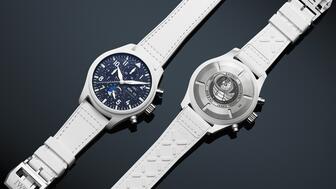Said to be the first to write a jewelry sales manual for the industry, Zell is remembered for his zest for life.
De Beers to Begin Selling Lab-Grown Diamond Jewelry
It is monumental, though not entirely shocking, jewelry industry news.

The jewelry will be sold direct to consumers via LightboxJewelry.com starting in September, with retail partnerships to be announced “in due course,” the company said in formally announcing the launch of Lightbox on Tuesday.
Lightbox Jewelry will be, at least for now, limited to fashion jewelry, necklaces and earrings set with white, blue and pink man-made diamonds that are “accessibly priced.”
De Beers is charging $200 for a piece of Lightbox Jewelry set with a 0.25-carat diamond; $400 for a half-carat diamond; $600 for 0.75 carats; and $800 for pieces set with a 1-carat man-made diamond. (Prices are for white, blue and pink diamonds and do not include the setting.)
In the company’s news release about Lightbox, both De Beers CEO Bruce Cleaver and Steve Coe, the general manager of Lightbox Jewelry, said the line aims to fill what De Beers perceives as a void in the market for well-priced lab-grown diamond fashion jewelry and to clear up consumer confusion over man-made diamonds.
“Our extensive research tells us this is how consumers regard lab-grown diamonds—as a fun, pretty product that shouldn’t cost that much—so we see an opportunity here that’s been missed by lab-grown diamond producers. Lab-grown diamonds are a product of technology, and as we’ve seen with synthetic sapphires, rubies and emeralds, as the technology advances, products become more affordable. After decades of R&D investment, we’re able to offer consumers a better price today,” Cleaver said.
He added that Lightbox Jewelry will be a “small business” compared to what De Beers sells in mined diamonds.
Coe said: “We’ve learned from our research that there is a lot of confusion about lab-grown diamonds—what they are, how they differ from diamonds and how they are valued. Lightbox will be clear with consumers about what lab-grown diamonds are and will offer straightforward pricing that is consistent with the true cost of production.”
He added that they will add more colors and designs to the line over time.
De Beers’ entrance into the lab-grown diamond jewelry market is monumental, although not entirely shocking, jewelry industry news. There has been speculation for years about when—not if—the company would employ its synthetic diamond arm, Element Six, to add gem-quality diamonds to its industrial production.
Element Six is based in Maidenhead, United Kingdom, and has grown diamonds for industrial purposes, for items such as drills, lasers and speakers, for years.
With the launch of Lightbox, De Beers is sinking $94 million over the next four years into a second Element Six facility near Portland, Oregon. Once fully operational, the plant will be capable of producing more than 500,000 carats of diamonds per year.
De Beers said Lightbox Jewelry will be the only company to which Element Six supplies gem-quality lab-grown diamonds.
All Lightbox diamonds that weigh 0.2 carats or more will be inscribed with a permanent logo inside the stone, visible only under a microscope, marking as a lab-grown diamond made by Element Six.
The Latest

The company outfitted the Polaris Dawn spaceflight crew with watches that will later be auctioned off to benefit St. Jude’s.

A buyer paid more than $100,000 for the gemstone known as “Little Willie,” setting a new auction record for a Scottish freshwater pearl.

Supplier Spotlight Sponsored by GIA.

Anita Gumuchian created the 18-karat yellow gold necklace using 189 carats of colored gemstones she spent the last 40 years collecting.


The three-stone ring was designed by Shahla Karimi Jewelry and represents Cuoco, her fiancé Tom Pelphrey, and their child.

The Manhattan jewelry store has partnered with Xarissa B. of Jewel Boxing on a necklace capsule collection.

Supplier Spotlight Sponsored by GIA

Acting as temporary virtual Post-it notes, Notes are designed to help strengthen mutual connections, not reach new audiences.

The jewelry historian discusses the history and cultural significance of jewelry throughout time and across the globe.

From fringe and tassels to pieces that give the illusion they are in motion, jewelry with movement is trending.

The designer and maker found community around her Philadelphia studio and creative inspiration on the sidewalks below it.

The change to accepted payment methods for Google Ads might seem like an irritation but actually is an opportunity, Emmanuel Raheb writes.

The industry consultant’s new book focuses on what she learned as an athlete recovering from a broken back.

The fair will take place on the West Coast for the first time, hosted by Altana Fine Jewelry in Oakland, California.

Hillelson is a second-generation diamantaire and CEO of Owl Financial Group.

Submissions in the categories of Jewelry Design, Media Excellence, and Retail Excellence will be accepted through this Friday, Aug. 23.


Known as “Little Willie,” it’s the largest freshwater pearl found in recent history in Scotland and is notable for its shape and color.

Clements Jewelers in Madisonville cited competition from larger retailers and online sellers as the driving factor.

Most of the 18th century royal jewelry taken from the Green Vault Museum in Dresden, Germany, in 2019 went back on display this week.

The Pittsburgh jeweler has opened a store in the nearby Nemacolin resort.

With a 40-carat cabochon emerald, this necklace is as powerful and elegant as a cat.

The Erlanger, Kentucky-based company was recognized for its reliability when it comes to repairs and fast turnaround times.

Unable to pay its debts, the ruby and sapphire miner is looking to restructure and become a “competitive and attractive” company.

The trend forecaster’s latest guide has intel on upcoming trends in the jewelry market.

Ingraham said she’ll use the scholarship funds to attend the Women’s Leadership Program at the Yale School of Management.

Moijey Fine Jewelry & Diamonds held a three-week “Mine to Finger 3D Jewelry Program.”



























